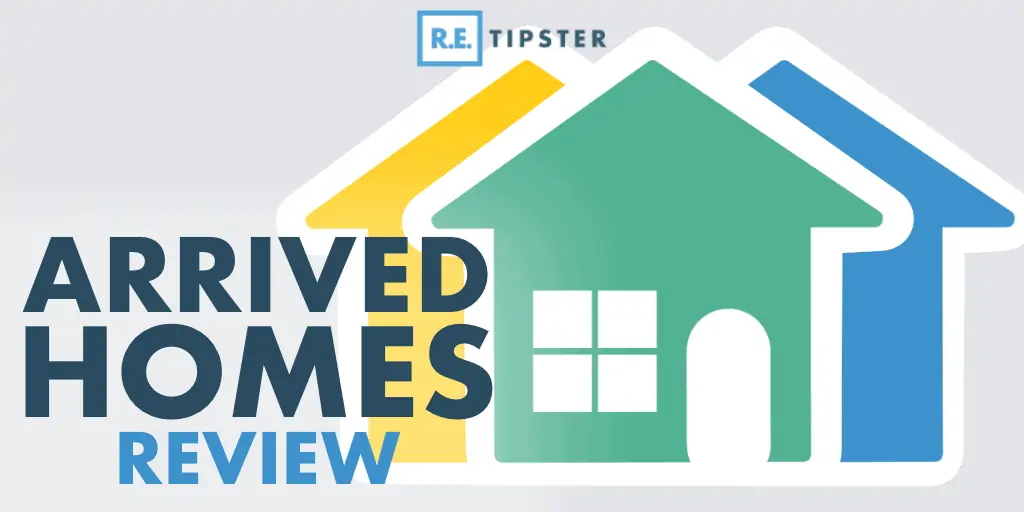
REtipster features products and services we find useful. If you buy something through the links below, we may receive a referral fee, which helps support our work. Learn more.
While many real estate crowdfunding platforms let you fractionally invest in large apartment complexes, Arrived Homes focuses on single-family rentals.
It’s an intriguing concept, owning shares in rental properties without the landlord headaches. But how well does it deliver on that promise?
Before investing in Arrived Homes, ensure you fully understand how it works.
Arrived Homes Rating
-
Overall Rating
Summary
Arrived Homes lets you buy shares in single-family rental properties for as little as $100. They buy long-term rentals and, more recently, short-term vacation properties to rent on Airbnb.
Arrived Homes buys properties under a Series LLC and then sells off fractional ownership. The ownership is technically structured as a REIT to minimize tax liability. Arrived Homes sells off 100% of each property, not keeping any ownership for themselves.
Typically, Arrived Homes sells the property on your behalf after five to seven years. At that time, all owners receive a payout proportional to their ownership share. In the meantime, you collect quarterly dividends reflecting the net rental income.
Pros
- Low Minimum Investment
- Easy Diversification
- Non-Accredited Investors Allowed
- Long-Term and Vacation Rentals Available
- Completely Passive Investing
- Full Tax Benefits
- No Legal Liability
- Transparent Fees
Cons
- Significant Fees
- Moderate Returns
- Lack of Liquidity
- Properties Not Always Available
- No Skin in the Game
What Is Arrived Homes?

Then they sell the ownership piecemeal to the public. You might share ownership of the property with 500 other investors.
Typically, Arrived Homes sells the property on your behalf after five to seven years. At that time, all owners receive a payout proportional to their ownership share.
In the meantime, you collect quarterly dividends reflecting the net rental income.
How Arrived Homes Works
Arrived Homes buys properties under a Series LLC and then sells off fractional ownership. The ownership is technically structured as a REIT to minimize tax liability. Arrived Homes sells off 100% of each property, not keeping any ownership for themselves.
When they buy the property, they sometimes — but not always — take out a mortgage. That leverage means you can share the home with fewer other owners and build equity faster than you would otherwise as the tenant pays down the loan. But it can also eat into the property’s cash flow.
Arrived Homes hires a third-party property management company to oversee the day-to-day operations. Which, of course, you and your fellow fractional owners pay for. You also pay two fees to Arrived Homes themselves: a one-time asset acquisition fee and an ongoing assets-under-management (AUM) fee. That latter is taken out of your quarterly distributions.
Unfortunately, once you buy in, there’s no getting out until the property sells. For now, Arrived Homes plans to let investors redeem shares early, presumably with a penalty. You can read their early redemption policy here, and here’s a snapshot of where it stands currently:
“Arrived has filed the planned redemption program with the U.S, Securities & Exchange Commission (SEC) and it is currently under review for Qualification. Arrived will not be able to support redemption requests until the program is reviewed and qualified.”
Arrived Homes Pros
There’s a lot to like about Arrived Homes. Consider the following as you explore investing money with them.
Low Minimum Investment
You can buy a little piece of a rental property for as little as $100. That’s pretty awesome.
Not everyone has $5,000 to invest with Streitwise or $50,000 to invest in a real estate syndication. But most middle-class Americans have $100 they could put toward an investment.
That makes it far more accessible to everyday working people, especially compared to saving up an entire down payment to buy a rental property by yourself.
Easy Diversification
With a $100 minimum investment, you can take the money you would have put toward a down payment on a single property and spread it among hundreds of properties.
It further helps that Arrived Homes operates in a dozen or so markets across the country and continues expanding. They particularly like the Midwest and Southeast, as far as I can tell.
All of which help you diversify across not just many properties but many cities and regions.
Non-Accredited Investors Allowed
That $100 minimum investment wouldn’t help much if they only allowed the rich to invest. Fortunately, they allow any U.S. resident over 18 to invest.
Compare that to crowdfunding platforms like Roofstock One, Crowdstreet, or Peerstreet, which only allow wealthy accredited investors to participate.
Long-Term and Vacation Rentals Available
In 2022, Arrived Homes added short-term vacation rentals to their portfolio. As you browse properties available for investing, you’ll see a cute little palm tree icon next to the vacation rentals.
Adding vacation rentals to your portfolio helps you further diversify it, as you’re effectively investing in the hospitality industry rather than housing.
Completely Passive Investing
You don’t have to lift a finger to invest in properties through Arrived Homes (aside from a few clicks, anyway).
Nor do you have to screen tenants, field 2 am phone calls, or hassle with unreliable contractors. You must choose the properties you like, enter an amount to invest, and e-sign on the dotted line. Arrived Homes does all the rest.
Full Tax Benefits
You receive nearly the same real estate tax benefits as a direct, individual property owner. That includes the full slate of tax deductions, including mortgage interest and depreciation.
Nor do you have to do any accounting yourself. Arrived Homes just sends you a 1099-DIV at the end of each year, for you to enter on your tax return.
You can’t use a 1031 exchange with Arrived Homes at the moment, however.
No Legal Liability
Landlords attract lawsuits and bottom-feeding attorneys like vultures. It’s a major drawback to investing in rental properties and one of several reasons why I personally no longer invest in them.
But as a passive investor with Arrived Homes, you don’t bear any personal legal liability. Someone could still sue the LLC that owns the property, and if they win, they could secure a lien against the property, but they can’t come after you personally.
Transparent Fees
Before buying shares in any property, you can see the one-time acquisition fee and the ongoing AUM fees listed. And estimates for other expenses, such as closing costs.
That’s reassuring, given how some real estate crowdfunding platforms try to hide fees in their offering circulars. I’m looking at you, HappyNest.
Arrived Homes Cons
For all those upsides, Arrived Homes has substantial drawbacks. Make sure you understand them fully before committing your hard-earned dough.
Significant Fees
While the fees vary, Arrived Homes charges an upfront sourcing fee of around 5% of the purchase price of each property. They also charge an annual AUM fee of around 0.5% of the total cost of onboarding the property.
Are these fees reasonable or too high? That’s for you to decide as an investor.
Moderate Returns
As a passive investor, you earn returns on both the net cash flow each year and the appreciation when the property sells. But don’t expect either to make you rich.
Most properties on Arrived Homes appear to offer income yields in the 3% to 5% range and average annual appreciation in a similar range. That means you’re looking at 6% to 10% total returns on your investment if all goes to plan. And having invested money myself around ten months ago, I’ve still seen almost no cash flow.
In other words, it makes for a reasonable way to diversify from the stock market and a viable alternative to bonds. You won’t be flying around on private jets any time soon, though.
Lack of Liquidity
Real estate is inherently a long-term investment. Whether you buy properties yourself or go in on them with 500 other investors on a crowdfunding platform, that remains the case.
Arrived Homes will probably offer an early redemption option soon. But even when they do, they’ll probably slap you with a gnarly penalty if you exercise it.
For now, there’s no way to sell your shares early, period.
Properties Not Always Available
In some ways, Arrived Homes is a victim of its own success. It did such a good job marketing itself that it has more investors on the platform than it can consistently service.
When you log onto the platform, they may or may not have any properties available to invest in. You can sign up to be alerted when new properties become available, so when that email hits your inbox, you can jump on new properties.
No Skin in the Game
It always worries me when the person or company offering an investment doesn’t have any of their own money tied up in it. Arrived Homes claims that they don’t invest in any of the properties to avoid a conflict of interest, but the opposite seems true to me.
Given their fee structure, they make money based on the volume of properties they deliver, not the quality of the returns. That’s especially worrying given the rabid demand among investors for more more more properties from them.
How Arrived Homes Compares
On the plus side, I don’t know anywhere else where I can buy fractional ownership in a single-family rental property, as a non-accredited investor, especially for just $100.
A few other crowdfunding platforms let you invest with less, such as Groundfloor and Fundrise, with their $10 minimum. But both represent entirely different types of investments.
At $100 a pop, you can spread your money among dozens, even hundreds of properties across the country. All for the same amount you’d spend on a down payment for a median U.S. home.
It’s hard for me to get excited about the returns, at 6% to 10% per year. Those aren’t bad returns; they’re just not exciting, either. In contrast, Fundrise has delivered an average annual return of around 14% for Seth over the last five years (see his full Fundrise review here). I also haven’t seen them deliver much in the way of returns on my own investments with them, despite having invested nearly a year ago.
I don’t love the five-to-seven-year lockup of capital, especially without an early redemption option. While Groundfloor doesn’t offer one either, they typically only tie up your money for 2 to 12 months. And Fundrise does offer early withdrawals at a reasonable 1% early redemption penalty. Other platforms like Concreit offer lower returns but fast liquidity.
I do like Arrived Homes as an alternative to Streitwise at their current yield. And while LEX Markets offers great liquidity at a similar minimum investment, they don’t offer the same breadth of properties as Arrived Homes.
Final Thoughts
I like Arrived Homes for its diversification value and its more stable alternative to high-yield stocks or bonds. But I also temper my return expectations, knowing I’ll probably earn somewhere in the same range as those more mainstream alternatives.
Arrived Homes specializes in B+ and above properties, with professional management, which keeps the risks relatively low. That puts the risk somewhere in the low-mid range and the returns in the mid-high range. Not a bad ratio as long as you understand the drawbacks and accept modest returns on a long-term investment.














